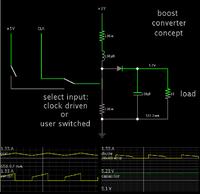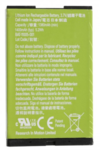Eshal
Advanced Member level 1
- Joined
- Aug 29, 2012
- Messages
- 470
- Helped
- 16
- Reputation
- 32
- Reaction score
- 15
- Trophy points
- 1,298
- Location
- Nowhere :)
- Activity points
- 5,149
Hello experts!
Here is my new thread about Boost converter.
Here is its schematic.

Here is mode 1 (When S is On)

Here is mode 2 (When S is Off)

Given:
Vs = 3V
Vo = 5.2V
Find:
value of inductor (L) = ?
Value of capacitor (C) = ?
Value of Resistor (R) = ?
Which Diode (D) should be use = ?
Assumptions:
Ideal switch that's why MOSFET or BJT or IGBT is replaced with SPST switch.
Experts, I want to design it. If there is any lack of information about this circuit for designing then let me know. But I want help and please be specific with post and title. Ofcourse you are mostly professionals but I am a learner so sometimes you talk very high which I could not understand and they are passed over my head. So please try teach like you are teaching in the class room and exams are on the head and you need to cover the most important points.
Thank you very much.
Here is my new thread about Boost converter.
Here is its schematic.

Here is mode 1 (When S is On)

Here is mode 2 (When S is Off)

Given:
Vs = 3V
Vo = 5.2V
Find:
value of inductor (L) = ?
Value of capacitor (C) = ?
Value of Resistor (R) = ?
Which Diode (D) should be use = ?
Assumptions:
Ideal switch that's why MOSFET or BJT or IGBT is replaced with SPST switch.
Experts, I want to design it. If there is any lack of information about this circuit for designing then let me know. But I want help and please be specific with post and title. Ofcourse you are mostly professionals but I am a learner so sometimes you talk very high which I could not understand and they are passed over my head. So please try teach like you are teaching in the class room and exams are on the head and you need to cover the most important points.
Thank you very much.


